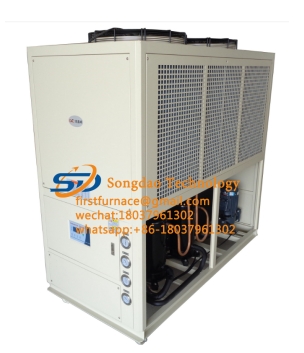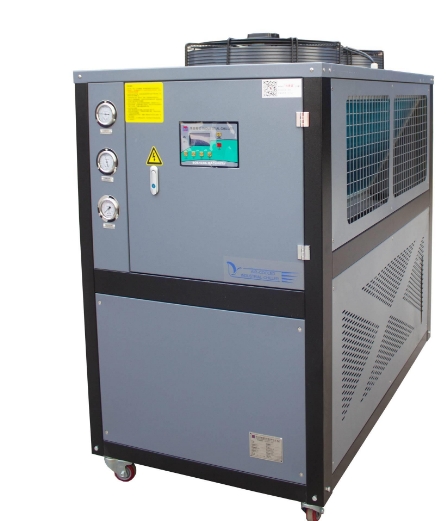- 04
- Nov
The troubleshooting method of the phenomenon that the compressor liquid hits the cylinder in the industrial chiller system
The troubleshooting method of the phenomenon that the compressor liquid hits the cylinder in the industrial chiller system
1. Causes of wet stroke failure
① When using manual control, the throttle valve is improperly adjusted, the opening is too large, or the float valve is not closed tightly;
②The thermal expansion valve fails, or the temperature sensing bulb is installed incorrectly, and the contact is not real, resulting in excessive opening;
③The evaporator coil is too thick and the load is too small;
④ Excessive oil accumulation in the system;
⑤The cooling capacity of the compressor is too large, or the heat load of the warehouse is small;
⑥ Improper adjustment of valve operation;
⑦The refrigerant in the refrigeration system is filled with too much refrigerant;
⑧The liquid supply solenoid valve is not closed tightly;
⑨In the two-stage compression refrigeration cycle, when the suction valve of the low pressure stage is suddenly closed or opened (or the number of operating units suddenly decreases and increases), and in the intercooler. The serpentine coil suddenly enters the liquid, which can easily cause the wet stroke of the high-pressure stage compressor.
In short, there are many factors that cause the wet stroke of the compressor, and the reasons should be found out and eliminated according to the specific situation.

2. Instruments, tools and equipment used to detect the failure of the wet stroke of the refrigeration compressor
①Instrument: pressure gauge, multimeter, clamp meter, thermometer, double qi meter.
②Tools: wrenches, pipe expansion tools, filling valves, pointed pliers, pliers, flashlights, special tools.
③Equipment: working fluid bottle, nitrogen bottle, vacuum pump, complete set of gas welding.
3. The general operation method to detect the wet stroke failure of the refrigeration compressor
Since the refrigeration system of industrial chillers is a complex system composed of condensers, evaporators, expansion valves, and many equipment accessories that are interrelated and influencing each other, once the refrigeration device fails, one should not only focus on certain On a local level, it is necessary to conduct a comprehensive inspection and comprehensive analysis of the entire system. In a nutshell, the general method of detection is:
“One listen, two touch, three look, four analysis” a set of basic methods.
One look: look at the suction pressure and discharge pressure of the compressor; look at the cooling rate of the cooling chamber; look at the frosting state of the evaporator; look at the frosting situation of the thermal expansion valve.
Second listening: listening to the sound of the compressor running, there should be only the clear movement of the valve. When there is a “through-through” sound, it is the impact sound of liquid hammer; listen to the sound of refrigerant flowing in the expansion valve; listen to the sound of the cooling fan; listen to the sound of the solenoid valve; listen to whether there is obvious vibration in the pipeline.
Three touches: touch the temperature of the front and rear bearings of the compressor; touch the temperature of the compressor cylinder liner and cylinder head; touch the temperature of the suction and exhaust pipes. Four analysis: Use the relevant theories of the refrigeration device to analyze and judge the phenomenon, find the cause of the failure, and eliminate it in a targeted manner. The judgment of the liquid hammer failure is not only based on the frosting of the suction pipe, but mainly from the sharp drop in the exhaust temperature. At this time, the exhaust pressure will not change much, but the cylinder, crankcase, and exhaust chamber are all affected. Cold or frosty. In the case of hydraulic shock, it can damage the lubrication system, worsen the work of the oil pump, sharply shrink the cylinder wall, and pierce the cylinder head in severe cases.

4. The method of troubleshooting and restoring normal operation of refrigeration compressor wet stroke fault
Dealing with liquid shock accidents should be done promptly, and in serious cases, emergency vehicle handling should be carried out. When a slight wet stroke occurs in a single-stage compressor, only the compressor suction valve should be closed, the liquid supply valve of the evaporation system should be closed, or the liquid in the container should be reduced. noodle. And pay attention to the oil pressure and exhaust temperature. When the temperature rises to 50℃, try to open the suction valve. If the exhaust temperature continues to rise, you can continue to open it, and if the temperature drops, close it again.
For the “wet stroke” of a two-stage compressor, the treatment method of the low-pressure stage wet stroke is the same as that of a single-stage compressor. But when there is a large amount of ammonia rushing into the cylinder, the high-pressure compressor can be used to depressurize and evacuate through the intercooler. Before pumping down, the liquid in the intercooler should be drained into the drain bucket, and then the pressure should be reduced. The cylinder cooling water jacket and oil should be cooled before the pressure reduction: drain the cooling water in the device or open the large water valve.
When the liquid level of the intercooler is too high, the high-pressure compressor exhibits a “wet stroke”. The treatment method should first turn off the suction valve of the low-pressure compressor, and then turn off the suction valve of the high-pressure compressor and the liquid supply valve of the intercooler. If necessary, discharge the ammonia liquid in the intercooler into the discharge drum. If the high-pressure compressor is severely frosted, stop the low-pressure compressor. The subsequent treatment method is the same as that of the single-stage.
